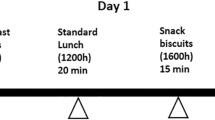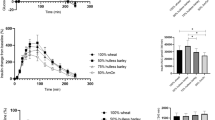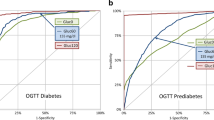Abstract
Background/Objectives:
a criticism of glycemic index (GI) is that it does not indicate the insulin response of foods (insulinemic index, II). However, it is unknown if the GI and II values of foods are equivalent in all subjects, a necessary criterion for clinical utility. We compared GI and II values in non-diabetic subjects with fasting-serum-insulin (FSI) <40 pmol/l (healthy control) or with FSI ⩾40 pmol/l (hyper[I]) and subjects with type 2 diabetes (T2DM), and to see whether GI and II were related to the serum-glucose concentrations, insulin sensitivity, β-cell function and hepatic insulin extraction (HIE) of the subjects.
Subjects/Methods:
Serum-glucose, -insulin and -C-peptide responses after 50 g available-carbohydrate portions of glucose (tested three times by each subject), sucrose, instant mashed-potato, white-bread, polished-rice and pearled-barley were measured in healthy control (n=9), hyper[I] (n=12) and T2DM (n=10) subjects.
Results:
Food GI values did not differ significantly among the three subject groups, whereas II values were higher in T2DM (100±7) than healthy controls (78±5) and hyper[I] subjects (70±5) (mean±s.e.m., P=0.05). II was inversely associated with insulin sensitivity (r=−0.66, P<0.0001) and positively related to fasting- and postprandial-glucose (both r=0.68, P<0.0001) and HIE (r=0.62, P=0.0002). In contrast, GI was not related to any of the biomarkers (P>0.05).
Conclusion:
The GI is a valid property of foods because its value is similar in healthy control, hyper [I] and T2DM subjects, and is independent of subjects’ metabolic status. However, II may depend upon the glycaemic control, insulin sensitivity and HIE of the subjects.
This is a preview of subscription content, access via your institution
Access options
Subscribe to this journal
Receive 12 print issues and online access
$259.00 per year
only $21.58 per issue
Buy this article
- Purchase on Springer Link
- Instant access to full article PDF
Prices may be subject to local taxes which are calculated during checkout


Similar content being viewed by others
References
Abdul-Ghani MA, Williams K, DeFronzo RA, Stern M (2007). What is the best predictor of future type 2 diabetes? Diabetes Care 30, 1544–1548.
Atkinson FS (2008). International tables of glycemic index and glycemic load values. Diabetes Care 31, 2281–2283.
Bao J, De Jong V, Atkinson F, Petocz P, Brand-Miller JC (2009). Food insulin index: physiologic basis for predicting insulin demand evoked by composite meals. Am J Clin Nutr 90, 986–992.
Barclay AW, Petocz P, McMillan-Price J, Flood VM, Prvan T, Mitchell P et al. (2008). Glycemic index, glycemic load, and chronic disease risk—a metaanalysis of observational studies. Am J Clin Nutr 87, 627–637.
Drucker DJ, Nauck MA (2006). The incretin system: glucagon-like peptide-1 receptor agonists and dipeptidyl peptidase-4 inhibitors in type 2 diabetes. Lancet 368, 1696–1705.
Ebbeling CB, Leidig MM, Feldman HA, Lovesky MM, Ludwig DS (2007). Effects of a low-glycemic load vs low-fat diet in obese young adults: a randomized trial. JAMA 297, 2092–2102.
Foster-Powell K, Holt SHA, Brand-Miller JC (2002). International table of gylcemic index and glycemic load values: 2002. Am J Clin Nutr 76, 5–56.
Holt SHA, Brand Miller JC, Petocz P (1997). An insulin index of foods: the insulin demand generated by 1000-kJ portions of common foods. Am J Clin Nutr 66, 1264–1276.
Jenkins DJA, Wolever TMS, Jenkins AL (1986). Low glycemic response to traditionally processed wheat and rye products: Bulgur and pumpernickel bread. Am J Clin Nutr 43, 516–520.
Jenkins DJA, Wolever TMS, Jenkins AL (1983). The glycaemic index of foods tested in diabetic patients: a new basis for carbohydrate exchange favouring the use of legumes. Diabetologia 24, 257–264.
Jenkins DJA, Wolever TMS, Taylor RH (1981). Glycemic index of foods: a physiological basis for carbohydrate exchange. Am J Clin Nutr 34, 362–366.
Laakso M (1993). How good a marker is insulin level for insulin resistance? Am J Epidemiol 137, 959–965.
Lazic SE (2008). Why we should use simpler models if the data allow this: relevance for ANOVA designs in experimental biology. BMC physiol 8, 16.
Lee BM, Wolever TMS (1998). Effect of glucose, sucrose and fructose on plasma glucose and insulin responses in normal humans: comparison with white bread. Eur J Clin Nutr 52, 924–928.
Mari A, Pacini G, Murphy E, Ludvik B, Nolan JJ (2001). A model-based method for assessing insulin sensitivity from the oral glucose tolerance test. Diabetes Care 24, 539–548.
Meier JJ, Nauck MA (2005). Glucagon-like peptide 1(GLP-1) in biology and pathology. Diabetes Metab Res 21, 91–117.
Miller JB, Pang E, Broomhead L (1995). The glycaemic index of foods containing sugars: comparison of foods with naturally-occurring v. Added sugars. Br J Nutr 73, 613–623.
Moghaddam E, Vogt JA, Wolever TMS (2006). The effects of fat and protein on glycemic responses in nondiabetic humans vary with waist circumference, fasting plasma insulin, and dietary fiber intake. J Nutr 136, 2506–2511.
Nilsson P, Nilsson J, Hedblad B, Eriksson K, Berglund G (2003). Hyperinsulinaemia as long-term predictor of death and ischaemic heart disease in nondiabetic men: The Malmö Preventive Project. J Intern Med 253, 136–145.
O’Brien RM (2007). A caution regarding rules of thumb for variance inflation factors. Qual Quant 41, 673–690.
Oh K, Hu FB, Cho E, Rexrode KM, Stampfer MJ, Manson JE et al. (2005). Carbohydrate intake, glycemic index, glycemic load, and dietary fiber in relation to risk of stroke in women. Am J Epidemiol 161, 161–169.
Polonsky KS, Rubenstein AH (1984). C-peptide as a measure of the secretion and hepatic extraction of insulin. Pitfalls and limitations. Diabetes 33, 486–494.
Stern MP, Williams K, Haffner SM (2002). Identification of persons at high risk for type 2 diabetes mellitus: do we need the oral glucose tolerance test? Ann Intern Med 136, 575–581.
Takahashi F, Hasebe N, Kawashima E, Takehara N, Aizawa Y, Akasaka K et al. (2006). Hyperinsulinemia is an independent predictor for complex atherosclerotic lesion of thoracic aorta in non-diabetic patients. Atherosclerosis 187, 336–342.
Wolever TMS (2003). Determination of the glycaemic index of foods: Interlaboratory study. Eur J Clin Nutr 57, 475.
Wolever TMS, Jenkins AL, Vuksan V, Campbell J (2009). The glycaemic index values of foods containing fructose are affected by metabolic differences between subjects. Eur J Clin Nutr 63, 1106–1114.
Wolever TMS, Campbell JE, Geleva D, Anderson GH (2004). High-fiber cereal reduces postprandial insulin responses in hyperinsulinemic but not normoinsulinemic subjects. Diabetes Care 27, 1281–1285.
Wolever TMS, Chiasson J, Csima A, Hunt JA, Palmason C, Ross SA et al. (1998). Variation of postprandial plasma glucose, palatability, and symptoms associated with a standardized mixed test meal versus 75 g oral glucose. Diabetes Care 21, 336–340.
Wolever TMS, Jenkins DJA, Collier GR, Ehrlich RM, Josse RG, Wong GS et al. (1988). The glycaemic index: effect of age in insulin dependent diabetes mellitus. Diabetes Res 7, 71–74.
Wolever TMS, Jenkins DJA, Jenkins AL, Josse RG (1991). The glycemic index: methodology and clinical implications. Am J Clin Nutr 54, 846–854.
Wolever TMS, Jenkins DJA, Josse RG, Wong GS, Lee R (1987). The glycemic index: similarity of values derived in insulin-dependent and non-insulin-dependent diabetic patients. J Am Coll Nutr 6, 295–305.
Wolever TMS, Jenkins DJA, Kalmusky J (1986). Comparison of regular and parboiled rices: explanation of discrepancies between reported glycemic responses to rice. Nutr Res 6, 349–357.
Xavier Pi-Sunyer F (2002). Glycemic index and disease. Am J Clin Nutr 76, 290S–298S.
Acknowledgements
XLP designed and ran the study, collected and analyzed data, and wrote the manuscript. TMSW designed and secured funding for the study and wrote the manuscript. XLP was supported by St Michael's Hospital-Li Ka Shing Knowledge Institute Scholarship and Ontario Graduate Scholarship (OGS). The study was supported by Canadian Institute of Health Research (CIHR) operating grant MOP-79382. We thank Melissa Kwong for GLP-1 measurements and Cindy Huang, Michelle Liu for assistance with the running of the study and data entry. The study was presented in poster form at the 28th International Symposium on Diabetes and Nutrition of the Diabetes and Nutrition Study Group (DNSG) of the EASD, 1–4 July, 2010, Oslo, Norway.
Author information
Authors and Affiliations
Corresponding author
Ethics declarations
Competing interests
XLP declares no conflict of interest. TMSW is the president and part owner of Glycemic Index Laboratories Inc. and Glycemic Index Testing Inc.
Rights and permissions
About this article
Cite this article
Lan-Pidhainy, X., Wolever, T. Are the glycemic and insulinemic index values of carbohydrate foods similar in healthy control, hyperinsulinemic and type 2 diabetic patients?. Eur J Clin Nutr 65, 727–734 (2011). https://doi.org/10.1038/ejcn.2011.28
Received:
Revised:
Accepted:
Published:
Issue Date:
DOI: https://doi.org/10.1038/ejcn.2011.28
Keywords
This article is cited by
-
The effect of oat β-glucan on postprandial blood glucose and insulin responses: a systematic review and meta-analysis
European Journal of Clinical Nutrition (2021)
-
Personalized nutrition by prediction of glycaemic responses: fact or fantasy?
European Journal of Clinical Nutrition (2016)
-
Effect of low-glycemic-sugar-sweetened beverages on glucose metabolism and macronutrient oxidation in healthy men
International Journal of Obesity (2016)
-
Effect of ethnicity on glycaemic index: a systematic review and meta-analysis
Nutrition & Diabetes (2015)
-
Is glycaemic index (GI) a valid measure of carbohydrate quality?
European Journal of Clinical Nutrition (2013)



